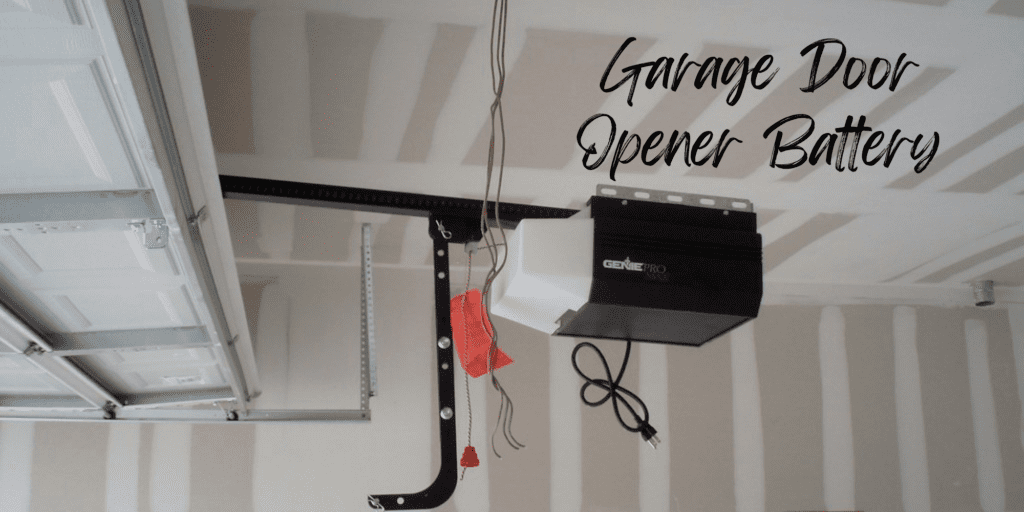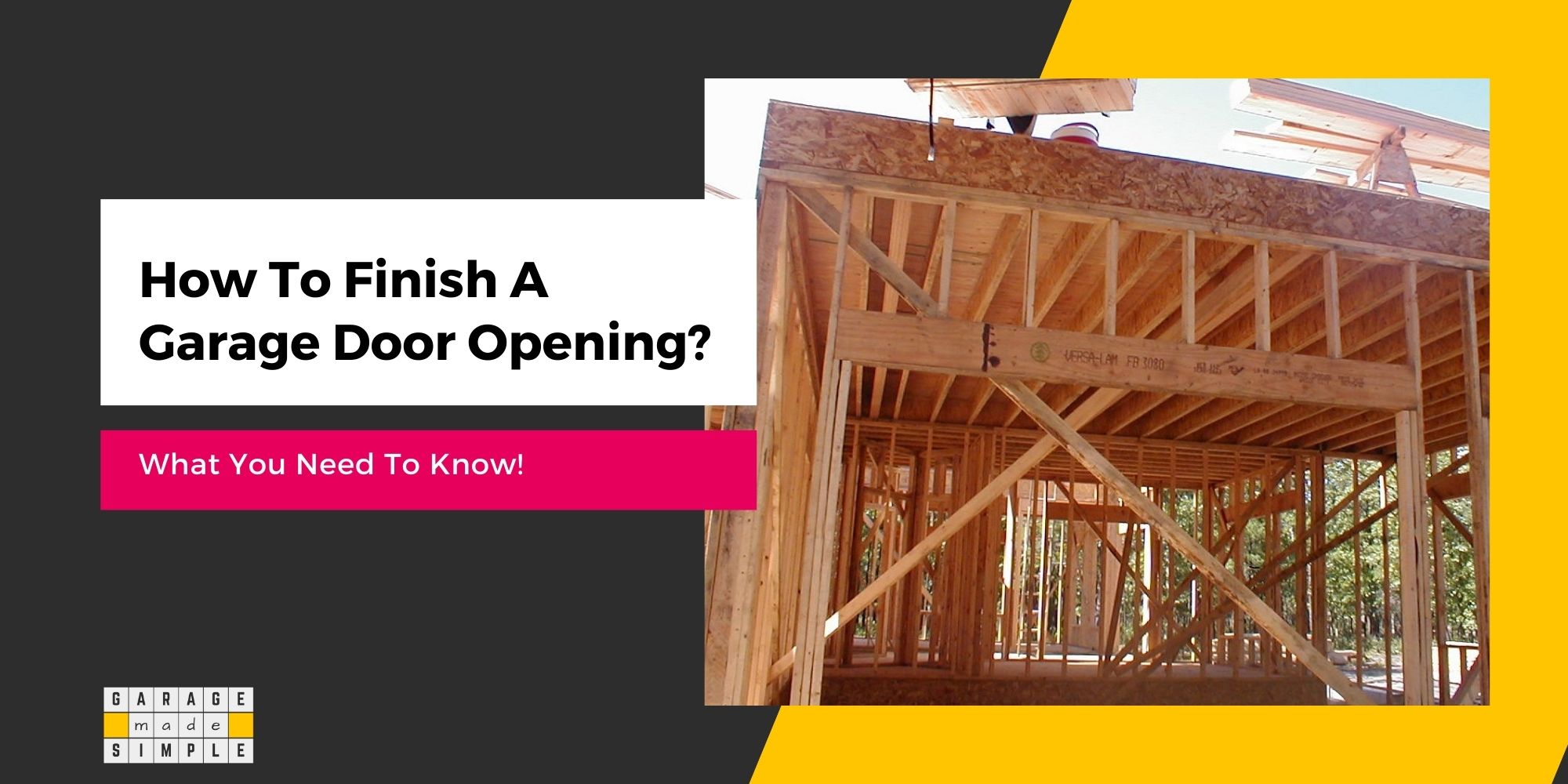Importance of Garage Door Opener Battery: Ultimate Guide
As an Amazon Associate, I earn from qualifying purchases.
The garage door opener battery lets you operate your garage door normally during a power outage. The garage door opener battery backup is more than just a convenience. It can save lives in emergencies like wildfires, snow storms or hurricanes!
In this blog post, I will cover important aspects of a garage door opener backup battery.
For information on garage door opener remotes and their battery, please check out my other post 5 Important Things You Need To Know About Garage Door Opener Remote.

Key Takeaways:
- Garage door opener batteries typically last 1-2 years.
- A garage door opener backup battery is mandatory in California. Many garage door opener models now come with backup batteries. They increase safety & convenience.
- Test your garage door opener battery regularly to make sure it is charging & working properly.
- If your garage door opener operates slower than usual, hesitates, or exhibits inconsistent movements, it might be a sign of a weakening battery.
- Replacing a garage door opener backup battery is quite easy.
- Just make sure the replacement battery is the correct voltage for your garage door opener.
The Importance of a Garage Door Opener Battery
A garage door opener battery is essential during emergencies, providing backup power in case of an outage.
Emergencies such as wildfires, storms, or other natural disasters often result in a power outage. A quick exit could save lives!

The garage door opener battery automatically activates, allowing uninterrupted access to open or close your garage door,
Typically, the battery lasts 24 hours, supporting around 20 open-close cycles, giving ample time to address any power issues or leave safely in an emergency.
Enhanced Safety
The battery also powers crucial safety features, such as sensors and auto-reverse mechanisms, preventing accidents even during power failures.
It ensures the full functionality of the garage door opener system—including the motor, sensors, lights, and control circuitry.
Types of Drives
There are three main types of overhead garage door opener drives: Chain Drive, Belt Drive, and Screw Drive. Alternatively, you may have a wall-mount garage door opener.
Regardless of the type, the battery backup operates similarly across all models.
Types of Batteries for Garage Door Openers
There are two main types of batteries used in garage door openers: standard batteries and rechargeable batteries.

Here is a brief explanation along with the pros and cons of each to help you make the best choice for your setup.
1. Standard Batteries
Standard batteries, often alkaline or lithium, are a common choice for garage door openers due to their easy availability and relatively low upfront cost.
- Pros:
- Ease of Replacement: Standard batteries are easy to find and replace, as they are available at most hardware and big box stores.
- Long Battery Life: High-quality standard batteries, especially lithium, tend to offer a stable battery life, powering your garage door opener for months before needing a replacement.
- Cons:
- Ongoing Replacement Cost: While inexpensive individually, the cost can add up over time as you need to replace these batteries every few months.
- Environmental Impact: Standard batteries need proper disposal to avoid environmental harm, as they contain materials that can be harmful if not discarded properly.
Pro Tip: If you choose standard batteries, remember to monitor your opener for warning signs of a failing battery, like slow or inconsistent door movement, and replace the battery promptly to maintain reliability.
2. Rechargeable Batteries
Rechargeable batteries are a more sustainable option and are becoming increasingly popular for homeowners looking for an eco-friendly alternative.
- Pros:
- Cost-Effective Over Time: While they require a higher initial investment, rechargeable batteries can be reused many times, reducing long-term costs.
- Environmentally Friendly: Rechargeable batteries reduce waste and lower the environmental impact compared to disposable options.
- Cons:
- Shorter Battery Life Between Charges: Rechargeable batteries may require recharging more frequently than the replacement interval for standard batteries.
- Battery Backup Limitations: Some rechargeable batteries may not provide as long-lasting a backup as high-capacity standard batteries, which can be a concern during power outages.
Pro Tip: For rechargeable options, create a schedule for how often to replace or recharge the battery to ensure it’s always ready to go.
Choosing and Disposing of Your Garage Door Opener Battery
Both standard and rechargeable batteries have their benefits, so choosing the right battery depends on your budget, environmental goals, and maintenance preferences.
Please follow proper disposal guidelines when it’s time to replace a battery. Many hardware stores accept used batteries for safe recycling, helping you keep your garage door opener functional without harming the environment.
Do All Garage Door Openers Have Batteries?
No. In fact, most garage door openers do not have batteries. A garage door opener backup battery obviously increases the cost.
In the past, a backup battery was not considered necessary. Extreme weather conditions were less common. Power infrastructure was quite robust. As a result, power outages were less common.
In the worst case, you could always pull the emergency release cord and shift from electric to manual mode.
However, the tragic 2017 wildfires in California taught legislators, homeowners, and garage door opener manufacturers a lesson.
Why Battery Backup for Garage Door Openers Matters
There are three reasons for having a Garage Door Opener Battery Backup.

Legal Requirement
There is no federal mandate for battery backup in garage door openers. However, California requires it by law.
Senate Bill No. 969 (SB-969), enacted on July 1, 2019, mandates that all new automatic garage door openers sold or installed in California must include battery backup.
If you live in California, compliance is mandatory.
Safety Benefits
While not mandatory elsewhere, a battery backup enhances safety. During emergencies like wildfires, hurricanes, or snowstorms, power outages are common, yet access to your garage may be crucial—for evacuation or supplies.
Battery backup ensures you can open and close your garage door when it matters most, providing peace of mind in uncertain situations.
Convenience and Flexibility
Battery backup adds convenience, allowing you to use your garage door even during planned outages. It ensures flexibility, letting you keep your schedule without being restricted by power availability.
Recommended Models of Garage Door Openers with Battery Backup
Now reputed manufacturers offer both built-in and aftermarket garage door battery backup. Here are some of the top-selling models.
1. Chamberlain B970T Smart Garage Door Opener with Battery Backup
Chamberlain B970T Smart Garage Door Opener with Battery Backup
The smart garage door opener with myQ technology lets you monitor and control the door remotely, even during power outages, thanks to the battery backup.
Its ultra-quiet steel-reinforced belt drive ensures durability, while Triband tech extends the remote range to 1,500 feet.
2. Genie 7155-TKV Smart Garage Door Opener with Battery Backup
Genie 7155-TKV Smart Garage Door Opener with Battery Backup
The Genie Stealth Drive Connect smart garage door opener offers in-garage delivery with Amazon Key and remote control via Aladdin Connect.
Its 1¼ HP motor and quiet belt drive suit attached garages, while battery backup and easy assembly add convenience.
3. Chamberlain RJO101MC Ultra-Quiet Wall Mounted with Battery Backup
Chamberlain RJO101MC Ultra-Quiet Wall Mounted with Battery Backup
The wall-mounted RJO series garage opener frees ceiling space, reduces noise, and offers ultra-quiet operation.
Features include smartphone control via myQ, battery backup for outages, and remote LED lighting with up to 8 pods for full garage illumination.
4. Genie B6172H Wall Mount Garage Door Opener with Battery Backup
Genie B6172H Wall Mount Garage Door Opener with Battery Backup
The Genie Wall Mount Smart Garage Door Opener offers smartphone control via Aladdin Connect and supports Amazon, Alexa, and more.
Its compact, space-saving design features a powerful 24v DC motor for doors up to 850 lbs, Safe-T-Pulse cable monitoring, and battery backup.
Are Battery Backup Garage Door Openers Worth It?
If you are a resident of California, the above question is irrelevant. You do not have a choice. By law, you have to have a battery backup garage door opener!
For comparable features, a battery backup garage door opener may cost an extra $50, or so.
For example, the B750 ULTRA-QUIET WI-FI GARAGE DOOR OPENER WITH WIRELESS KEYPAD will cost you $198, while a B970 ULTRA-QUIET WI-FI BATTERY BACKUP GARAGE DOOR OPENER WIRELESS KEYPAD will cost you $245 at Home Depot.
They have similar features except that B970 has a more powerful motor and battery backup.
Spending an extra $50 for convenience and peace of mind is certainly worth it, in my opinion.
You will need to replace the battery every 1-2 years which costs around $30.
Upgrading Your Garage Door Opener with a Battery Backup
What are your options if you have a garage door opener without a battery backup? You can always add a battery backup to your existing garage door opener. It will give you the convenience and peace of mind that you are safe.
This upgrade ensures you can still open and close your garage door, even if the power goes out. This added reliability can be invaluable in emergencies.
Many garage door openers, especially newer models, support battery backup options, but compatibility varies by brand and model.
Major brands like LiftMaster, Chamberlain, and Genie often have battery add-ons for recent models, but older openers may not support retrofits and might require a full replacement.
To check compatibility, locate your model number and consult your owner’s manual or the manufacturer’s website.
Choosing and Installing the Right Battery Backup
Batteries provide DC electricity. That is why the garage door opener motor in a battery backup garage door is always DC and never AC.
If your garage door opener is compatible, here’s what to consider when choosing a backup battery system:
- Battery Type: Look for a battery designed for your opener’s brand to ensure compatibility and reliable performance. Many backup batteries are rechargeable, lasting 1–2 years with regular use.
- Ease of Installation: Most battery units are plug-and-play, easily connecting to the opener. Follow the installation instructions carefully; if wiring or mounting becomes complex, consider hiring a professional.
- Recommended Options: Each brand typically offers proprietary battery units for optimal compatibility. For example, the LiftMaster 485LM, Chamberlain battery systems, and Genie’s compatible batteries are top choices for these respective brands.
To install, connect the battery according to the manual, ensuring secure placement and testing the operation by briefly disconnecting the power.
Garage Door Opener Batteries Service Life
A garage door opener rechargeable battery will last approximately 1-2 years. The battery recharges automatically during normal opener use, prolonging its life.
The garage door opener will beep, and the battery status LED will turn red to indicate the battery needs to be replaced.
You should disconnect the battery if you plan to unplug the garage door opener for long periods. This will increase battery life and prevent damage.
This may be the case if you happen to have a garage at your lakeside cottage or a mountain holiday home that you use only a few months in a year.
How To Check a Garage Door Opener Battery?
Checking a garage door opener battery is a relatively easy process.
Most garage door openers have a battery indicator light. If it’s green, your battery is functioning well. If it’s red or not lit at all, your battery may need attention.
Locate the battery within your garage door opener unit. Typically, it’s a small rectangular box connected to the motor.
Next, test the battery’s voltage using a multimeter, a handy tool available at hardware stores. Set the multimeter to DC voltage and touch its probes to the battery terminals.
A healthy 12-volt battery should read around 12.6 to 12.8 volts. Anything significantly lower indicates a weak or failing battery that needs replacement.
TIP: Pay attention to your garage door’s performance. If it operates slower than usual, hesitates, or exhibits inconsistent movements, it might be a sign of a weakening battery.
Replacing a Backup Battery on a Garage Door Opener
Replacing a backup battery in your garage door opener is not difficult. You just need to follow the steps below:
- Locate the Battery Compartment: It’s typically a small box connected to the motor unit. Refer to your garage door opener’s manual, if you’re having trouble locating it.
- Power Off the Opener: Ensure your garage door opener is disconnected from power.
- Remove the Old Battery: Open the battery compartment and carefully remove the old battery. Pay attention to how it’s placed. Make note of the positive and negative terminals.
- Choose the Right Replacement: Select a new battery that matches the specifications mentioned in your garage door opener manual.
- Install the New Battery: Insert the new battery into the compartment, matching the positive and negative terminals correctly. Ensure it fits snugly in place.
- Power On the Opener: Reconnect the power to your garage door opener. Wait for a few minutes to see if the battery indicator light (if present) turns green, indicating the new battery is functioning properly.
- Test the Garage Door: Test your garage door by opening and closing it a few times to ensure it operates smoothly with the new battery in place.
- Dispose of the Old Battery: Safely dispose of the old battery according to local regulations. Many hardware stores and recycling centers accept used batteries for recycling.
Here are a couple of replacement batteries to consider:
Liftmaster/Chamberlain Battery Backup Replacement 485LM
Liftmaster/Chamberlain Battery Backup Replacement 485LM
The Liftmaster 485LM replacement battery, compatible with models like 8500 and WLED, offers 2 days or 20 cycles during outages.
Each order includes an 8-in-1 stainless steel multi-tool. DIY replacement takes 7 steps with basic tools. It is 100% OEM quality.
2 Pack 12V 5AH Rechargeable Sealed Lead Acid Battery CA1250
2 Pack 12V 5AH Rechargeable Sealed Lead Acid Battery CA1250
The CA1250 is a 12V 5AH rechargeable SLA battery with high discharge rate, deep discharge recovery, and resistance to shocks and vibration.
It fits multiple models, operates in all temperatures, and measures 3.54″ x 2.76″ x 3.98″. It is battery—only, with no accessories included.
Remember, if you’re unsure about any step, consult your garage door opener’s manual or check out a YouTube video.
Maintenance and Troubleshooting Tips for Battery Backup Systems
A few steps can help keep your backup battery in top shape for consistent operation:
- Battery Life and Replacement: Backup batteries generally last 1–2 years. Signs of a failing battery include slower door response times or failure to work during outages. Regularly test the battery and replace it as needed.
- Proper Disposal: When it’s time to replace your battery, dispose of the old one responsibly. Many batteries contain chemicals that are hazardous to the environment, so please recycle them at a designated facility.
- Check Connections and Cleanliness: Periodically check for corrosion or loose connections. If any issues arise, consult your manual or a technician for assistance.
Thank you very much for reading the post. I do hope you found it informative and useful.












